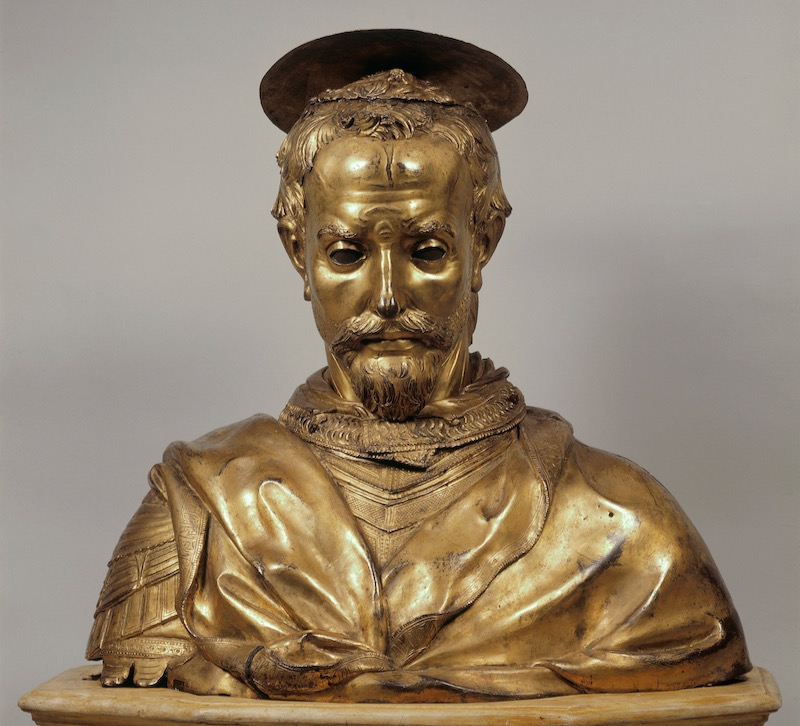Taking pride of place in the current Donatello exhibition at the Victoria and Albert Museum (Donatello: Sculpting the Renaissance until 11 June) is the Renaissance artist’s reliquary bust of San Rossore. This masterpiece of devotional art was created by around 1425 to house the relic of the skull of Saint Luxorius, who is known in Tuscany as San Rossore. Donatello’s reliquary marked a watershed moment both in terms of how the reliquary looked and the material from which it was made. Reliquaries in the shape of a body part, such as a saint’s head or arm, were not new. Such shapes instantly recalled the type of relic that was kept within it – in this case a skull.
The ninth-century reliquary of Saint Foy, in Conques, France, even depicts the whole person of the saint, enthroned. Influenced by antique portrait busts, however, Donatello produced a strikingly naturalistic portrait of a man from the shoulders up which was a departure from these previous works. With a downcast chin and furrowed brow, San Rossore is portrayed in the midst of saintly contemplation. The varied textures deployed by Donatello, from the curls of the saint’s hair and beard to the delicate edging of his cloak, add to the naturalistic effect. By using bronze to cast the bust, Donatello too was departing from convention. At this time, reliquaries were usually made from gilded silver or copper and decorated with precious stones or enamel, with less expensive examples made from wood. The bust of San Rossore was not made in one whole piece. Instead, it was cast in five pieces which were then assembled before the gilding and surface decoration was added. At the same time as the reliquary bust was under construction, Donatello and his workshop were using the same techniques to create the larger statue of Saint Louis of Toulouse for the external façade of a different Florentine church, Orsanmichele. That statue is now, however, in Santa Croce.
Donatello, born Donato di Niccolò di Betto in around 1386, was a Florentine sculptor. Early training as a goldsmith influenced his later sculpted works, including the reliquary bust of San Rossore. Working across terracotta, bronze, wood, marble and more, Donatello influenced later artists such as Michelangelo technically and aesthetically. Objects like the reliquary bust of San Rossore tell us something about how Renaissance artists worked. Although it is tempting to present artworks such as this as the sole creation of one master artist, in fact, many hands were at work. Donatello outsourced the bronze casting – the actual technical production – to another artisan, Giovanni di Jacopo. Bronze casting required a high level of specialist skill and expertise to create complex, detailed objects. Outsourcing to a specialist artisan such as Giovanni ensured a greater degree of success and less wastage. Recent exhibitions on Donatello, including that at the V&A, have done well to underline the collaborative nature of many of his works. Donatello’s practice was not unusual among Renaissance artists.
But who was the saint who merited such a ground-breaking reliquary? Although little-known today, Luxorius/Rossore was an important saint in early Renaissance Tuscany, not only devotionally but also politically. Donatello produced the reliquary for the church of Ognissanti, which is found just west of Florence’s city centre. Ognissanti was run by the Humiliati, or “humble ones”, a religious order which was active between the 12th and 16th centuries. However, Ognissanti had only held the relic of San Rossore’s skull since 1422. Before that, it had been in the hands of Pisa. At this time, Florence and Pisa were bitter rivals. However, Luxorius wasn’t Florentine or Pisan, but a third-century Roman soldier from what is now Sardinia, who had been martyred under Diocletian for his Christian faith. The saint’s feast day, 21 August, commemorates the supposed date of his beheading.
By the 13th century, Sardinia was under the dominion of the Republic of Pisa. Thus, the relics of Saint Luxorius came into Pisan hands, and were stored in the church of San Rossore in Pisa, which was also run by the Humiliati. In turn, Florence conquered Pisa in 1406. The prestigious relics of Saint Luxorius were eventually transferred from Pisa to Florence in a procession to take up their place at Ognissanti. The reliquary was a major commission for the Humiliati which took around five years to complete. It would most likely have been displayed to the faithful only on the saint’s feast days. In addition to Saint Luxorius’s August feast day, the Humiliati of Ognissanti inaugurated another commemorative day for the saint and the relic, which occurred on the Sunday following Ascension, to mark the transfer of the relics. Both days involved processions and rituals which also likely shone a votive focus on the relics. Saint Luxorius’s prestige was enhanced in Florence after the Florentine victory over Siena at the Battle of San Romano in 1432, fought on the saint’s Florentine feast day (following Ascension) and attributed to his particular intervention. After 1432, Ognissanti and the relic of Saint Luxorius formed the culmination of Florence’s commemorative celebrations of this victory. By 1591, the bust had been returned to Pisa, where it can now be viewed when not on display in exhibitions such as that at the Victoria and Albert Museum.
Louisa McKenzie is an art historian based at the Warburg Institute in London. Her research focusses on the devotional art and material culture of fourteenth and fifteenth-century Italy, with a specific focus on Tuscany. Louisa holds a doctorate from the Warburg Institute, University of London.



 Loading ...
Loading ...
What do you think?
You can post as a subscriber user ...
User comments (0)